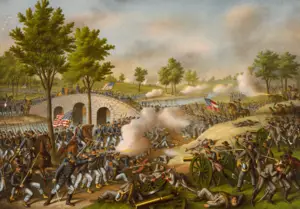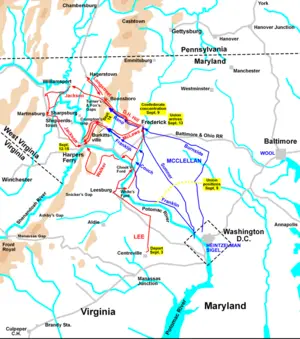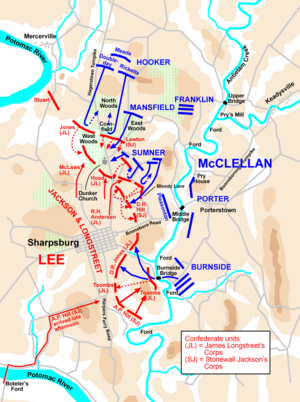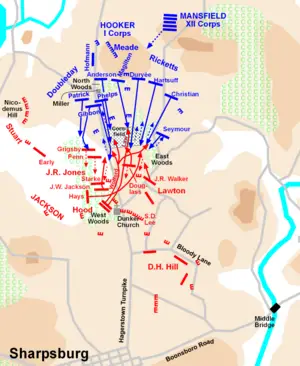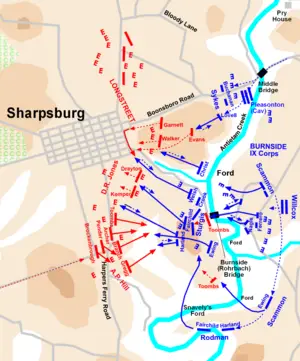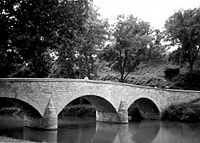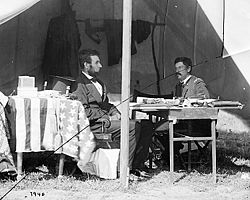Battle of Antietam
| ||||||||||||||||||||||||||||||
The Battle of Antietam (also known as the Battle of Sharpsburg, particularly in the South), fought on September 17, 1862, near Sharpsburg, Maryland, and Antietam Creek, as part of the Maryland Campaign, was the first major battle in the American Civil War to take place on Northern soil. It was the bloodiest single-day battle in American history, with almost 23,000 casualties.[1] More Americans were killed in this one-day campaign than in the Revolutionary War, War of 1812, Spanish-American War, and Mexican War combined.[2]
After pursuing Confederate General Robert E. Lee into Maryland, Union Army Major General George B. McClellan launched attacks against Lee's army, in defensive positions behind Antietam Creek. At dawn on September 17, Major General Joseph "Fighting Joe" Hooker's corps mounted a powerful assault on Lee's left flank. Attacks and counterattacks swept across Miller's cornfield and fighting swirled around the Dunker Church which was situated atop a small flat-topped hill. Union assaults against the Sunken Road eventually pierced the Confederate center, but the Federal advantage was not followed up. Late in the day, Major General Ambrose Burnside's corps finally got into action, crossing the stone bridge over Antietam Creek and rolling up the Confederate right. At a crucial moment, Major General Ambrose Pierce Hill's division arrived from Harpers Ferry and counterattacked, driving back Burnside and saving the day. Although outnumbered two-to-one, Lee committed his entire force, while McClellan sent in less than three-quarters of his army, enabling Lee to fight the Federals to a standstill. During the night, both armies consolidated their lines. In spite of crippling casualties, Lee continued to skirmish with McClellan throughout September 18, while removing his wounded south of the river.[3]
Despite having superiority of numbers, McClellan's attacks failed to achieve concentration of mass, allowing Lee to counter by shifting forces to meet each challenge and outraging President Lincoln back in Washington. Despite ample reserve forces that could have been deployed to exploit localized successes, McClellan failed to destroy Lee's army. Nevertheless, Lee's invasion of Maryland was ended, and he was able to withdraw his army back to Virginia without interference from the cautious McClellan. Although the battle was tactically inconclusive, it had unique significance as enough of a victory to give President Abraham Lincoln the confidence to announce his Emancipation Proclamation. It also discouraged major European powers such as France and England from supporting the Confederacy and perhaps altered the course of the war.[4]
Background and the Maryland campaign
Lee's Army of Northern Virginia—45,000 men—had entered the state of Maryland following their recent victory at Second Bull Run. Lee's strategy was to seek new supplies and recruits from the border, slave state of Maryland, which had considerable pockets of Confederate sympathizers, and to affect public opinion prior to the upcoming elections in the North. (As it turned out, the social impact of Lee's actions was otherwise mixed; Marylanders were not as thoroughly won over by the sounds of Maryland, My Maryland from the bands of the Army of Northern Virginia as Lee would have hoped, and the weak strategic victory of the Army of the Potomac at Antietam diminished any successes Lee may have had in winning the hearts and minds of the people of Maryland). Lee sought to raid in the North to boost his army’s resources. Some Confederate politicians, including Jefferson Davis, believed the prospect of foreign recognition for the Confederacy would be made stronger by a military victory on Northern soil; such a victory might gain recognition and financial support from Great Britain and France, although there is no evidence that Lee thought the South should base its military plans on this possibility. McClellan moved alongside Lee to protect the Union capital from invasion.[5][6]
While McClellan's 90,000-man Army of the Potomac was moving to intercept Lee, Union soldiers (Corporal Barton W. Mitchell and First Sergeant John M. Bloss[7][8] of the 27th Indiana Volunteer Infantry) discovered a mislaid copy of the detailed battle plans of Lee's army—Special Order 191—near Fredericksburg, Maryland wrapped around three cigars. The order indicated that Lee had divided his army and dispersed portions geographically (to Harpers Ferry, West Virginia to secure the gun factory and rail lines, and Hagerstown, Maryland to ensure that railways here where also safely controlled), thus making each subject to isolation and defeat in detail if McClellan could move quickly enough. McClellan waited about 18 hours before deciding to take advantage of this intelligence and position his forces based on it, thus squandering an opportunity to defeat Lee decisively. Again he had estimated his enemy to be far more numerous than it actually was, albeit with Lee's full battle plans in hand.[9]
There were two significant engagements in the Maryland campaign prior to the major battle of Antietam: Maj. Gen. Thomas J. "Stonewall" Jackson's capture of Harpers Ferry and McClellan's assault through the Blue Ridge Mountains in the Battle of South Mountain. The former was significant because a large portion of Lee's army was absent from the start of the battle of Antietam, attending to the surrender of the Union garrison; the latter because stout Confederate defenses at two passes through the mountains delayed McClellan's advance enough for Lee to concentrate the remainder of his army at Sharpsburg after he tried to close in on the Confederate army on September 14.[10]
Opposing forces
Confederate
General Robert E. Lee's Army of Northern Virginia was organized into two large infantry corps.[11]
The First Corps, under Maj. Gen. James Longstreet, consisted of the divisions of:
- Maj. Gen. Lafayette McLaws (brigades of Brig. Gens. Joseph B. Kershaw, Howell Cobb, Paul J. Semmes, and William Barksdale).
- Maj. Gen. Richard H. Anderson (brigades of Cols. Alfred Cumming, W.A. Parham, and Carnot Posey, and Brig. Gens. Lewis A. Armistead, Roger A. Pryor, and Ambrose R. Wright).
- Brig. Gen. David R. Jones (brigades of Brig. Gens. Robert A. Toombs, Thomas F. Drayton, Richard B. Garnett, James L. Kemper, and Cols. Joseph T. Walker and George T. Anderson).
- Brig. Gen. John G. Walker (brigades of Colonel Van H. Manning and Brig. Gen. Robert Ransom, Jr.).
- Brig. Gen. John Bell Hood (brigades of Cols. William T. Wofford, Evander M. Law, and Brig. Gen. Nathan G. "Shanks" Evans).
The Second Corps, under Maj. Gen. Thomas J. "Stonewall" Jackson, consisted of the divisions of:
- Brig. Gen. Alexander R. Lawton (brigades of Col. Marcellus Douglass, Brig. Gen. Jubal A. Early, Col. James A. Walker, and Brig. Gen. Harry T. Hays).
- Maj. Gen. A.P. Hill (the Light Division—brigades of Brig. Gens. Lawrence O'Bryan Branch, Maxcy Gregg, James J. Archer, and William Dorsey Pender, and Cols. John M. Brockenbrough and Edward L. Thomas).
- Brig. Gen. John R. Jones (brigades of Cols. A.J. Grigsby, E.T.H. Warren, Bradley T. Johnson, and Brig. Gen. William E. Starke).
- Maj. Gen. D.H. Hill (brigades of Brig. Gens. Roswell S. Ripley, Robert E. Rodes, Samuel Garland, Jr., George B. Anderson, and Col. Alfred H. Colquitt).
The remaining units were the Cavalry Corps, under Maj. Gen. J.E.B. Stuart, and the reserve artillery, commanded by Brig. Gen. William N. Pendleton. The Second Corps was organized with artillery attached to each division, in contrast to the First Corps, which reserved its artillery at the corps level.
Union
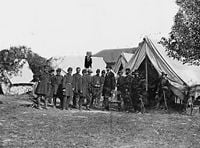
Maj. Gen. George B. McClellan's Army of the Potomac, bolstered by units absorbed from John Pope's Army of Virginia, included six infantry corps.[12]
The I Corps, under Maj. Gen. Joseph Hooker, consisted of the divisions of:
- Brig. Gen. Rufus King (brigades of Col. Walter Phelps and Brig. Gens. Abner Doubleday, Marsena R. Patrick, and John Gibbon).
- Brig. Gen. James B. Ricketts (brigades of Brig. Gen. Abram Duryée, Col. William A. Christian, and Brig. Gen. George L. Hartsuff).
- Brig. Gen. George G. Meade (brigades of Brig. Gen. Truman Seymour and Col. Thomas F. Gallagher).
The II Corps, under Maj. Gen. Edwin V. Sumner, consisted of the divisions of:
- Maj. Gen. Israel B. Richardson (brigades of Brig. Gen. John C. Caldwell, Brig. Gen. Thomas F. Meagher, and Col. John R. Brooke).
- Maj. Gen. John Sedgwick (brigades of Brig. Gens. Willis A. Gorman, Oliver O. Howard, and Napoleon J.T. Dana).
- Brig. Gen. William H. French (brigades of Brig. Gen. Nathan Kimball, Col. Dwight Morris, and Brig. Gen. Max Weber).
The V Corps, under Maj. Gen. Fitz John Porter, consisted of the divisions of:
- Maj. Gen. George W. Morell (brigades of Col. James Barnes, Brig. Gen. Charles Griffin, and Col. T.B.W. Stockton).
- Brig. Gen. George Sykes (brigades of Lt. Col. Robert C. Buchanan, Major Charles S. Lovell, and Col. Gouverneur K. Warren).
- Brig. Gen. Andrew A. Humphreys (brigades of Brig. Gen. Erastus B. Tyler and Col. Peter H. Allabach).
The VI Corps, under Maj. Gen. William B. Franklin, consisted of the divisions of:
- Maj. Gen. Henry W. Slocum (brigades of Col. Alfred T.A. Torbert, Col. Joseph J. Bartlett, and Brig. Gen. John Newton).
- Maj. Gen. William F. "Baldy" Smith (brigades of Brig. Gens. Winfield S. Hancock and William T. H. Brooks and Col. William H. Irwin).
- A division from the IV Corps under Maj. Gen. Darius N. Couch (brigades of Brig. Gens. Charles Devens, Jr., Albion P. Howe, and John Cochran).
The IX Corps, under Maj. Gen. Ambrose E. Burnside, consisted of the divisions of:
- Brig. Gen. Orlando B. Willcox (brigades of Cols. Benjamin C. Christ and Thomas Welsh).
- Brig. Gen. Samuel D. Sturgis (brigades of Brig. Gens. James Nagel and Edward Ferrero).
- Brig. Gen. Isaac P. Rodman (brigades of Cols. Harrison S. Fairchild and Edward Harland).
- Kanawha Division, under Brig. Gen. Jacob D. Cox (brigades of Cols. Hugh Ewing and George Crook).
The XII Corps, under Maj. Gen. Joseph K. Mansfield, consisted of the divisions of:
- Brig. Gen. Alpheus S. Williams (brigades of Brig. Gens. Samuel W. Crawford and George H. Gordon).
- Brig. Gen. George S. Greene (brigades of Lt. Col. Hector Tyndale, Col. Henry J. Stainrook, and Col. William B. Goodrich).
- Cavalry division of Brig. Gen. Alfred Pleasonton (brigades of Maj. Charles J. Whiting and Cols. John F. Farnsworth, Richard H. Rush, Andrew T. McReynolds, and Benjamin F. Davis).
Battle
Near the town of Sharpsburg, Lee deployed his available forces behind Antietam Creek along a low ridge, starting on September 15. It was an effective defensive position, although not an impregnable one. The terrain provided excellent cover for infantrymen, with rail and stone fences, outcroppings of limestone, and little hollows and swales. The creek to their front was only a minor barrier, ranging from 60 to 100 feet (18-30 m) in width, and was fordable in places and crossed by three stone bridges each a mile (1.5 km) apart. It was also a precarious position because the Confederate rear was blocked by the Potomac River and only a single crossing point, Boteler's Ford, was available should retreat be necessary. And on September 15, the force under Lee's immediate command consisted of no more than 18,000 men, only a third the size of the Federal army.[13]
The first two Union divisions arrived on the afternoon of September 15 and the bulk of the remainder of the army late that evening. Although an immediate Union attack on the morning of September 16 would have had an overwhelming advantage in numbers, McClellan's trademark caution and his belief that Lee had over 100,000 men caused him to delay his attack for a day. This gave the Confederates more time to prepare defensive positions and allowed Longstreet's corps to arrive from Hagerstown and Jackson's corps, minus A.P. Hill's division, to arrive from Harpers Ferry. Jackson defended the left (northern) flank, anchored on the Potomac, Longstreet the right (southern) flank, anchored on the Antietam, a line that was about 4 miles (6 km) long. (As the battle progressed and Lee shifted units, these corps boundaries overlapped considerably.)
On the evening of September 16, McClellan ordered Hooker's I Corps to cross Antietam Creek and probe the enemy positions. Meade's division cautiously attacked the Confederates under Hood near the East Woods. After darkness, artillery fire continued as McClellan continued to position his troops. McClellan's plan was to overwhelm the enemy's left flank. He arrived at this decision because of the configuration of bridges over the Antietam. The lower bridge (which would soon be named Burnside Bridge) was dominated by Confederate positions on the bluffs overlooking it. The middle bridge, on the road from Boonsboro, was subject to artillery fire from the heights near Sharpsburg. But the upper bridge was 2 miles (3 km) east of the Confederate guns and could be crossed safely. McClellan planned to commit more than half his army to the assault, starting with two corps, supported by a third, and if necessary a fourth. He intended to launch a simultaneous diversionary attack against the Confederate right with a fifth corps, and he was prepared to strike the center with his reserves if either attack succeeded.[14] The skirmish in the East Woods served to signal McClellan's intentions to Lee, who prepared his defenses accordingly. He shifted men to his left flank and sent urgent messages to his two commanders who had not yet arrived on the battlefield: Lafayette McLaws with two divisions and A.P. Hill with one division.
McClellan's plans were ill-coordinated and executed poorly. He issued to each of his subordinate commanders only the orders for his own corps, not general orders describing the entire battle plan. The terrain of the battlefield made it difficult for those commanders to monitor events outside of their sectors, and McClellan's headquarters were more than a mile in the rear (at the Philip Pry house, east of the creek), making it difficult for him to control the separate corps. Therefore, the battle progressed the next day as essentially three separate, mostly uncoordinated battles: Morning in the northern end of the battlefield, mid-day in the center, and afternoon in the south. This lack of coordination and concentration of McClellan's forces almost completely nullified the two-to-one advantage the Union enjoyed and allowed Lee to shift his defensive forces to meet each offensive, in effect producing a number of stalemates between the two armies on the battlefield.
Morning
The battle opened at dawn (about 5:30 a.m.) on September 17 with an attack down the Hagerstown Turnpike by the Union I Corps under Joseph Hooker. Hooker's objective was the plateau on which the Dunker Church sat, a modest whitewashed building belonging to a local sect of German Baptists. Hooker had approximately 8,600 men, little more than the 7,700 defenders under Stonewall Jackson, and this slight disparity was more than offset by the Confederates' strong defensive positions.[15] Abner Doubleday's division moved on Hooker's right, James Ricketts's moved on the left into the East Woods, and George Meade's Pennsylvania Reserves division deployed in the center and slightly to the rear. Jackson's defense consisted of the divisions under Alexander Lawton and John R. Jones in line from the West Woods, across the Turnpike, and along the southern end of the Miller Cornfield. Four brigades were held in reserve inside the West Woods.[16]
As the first Union men emerged from the North Woods and into the Cornfield, an artillery duel erupted. Confederate fire was from the horse artillery batteries under Jeb Stuart to the west and four batteries under Col. Stephen D. Lee on the high ground across the pike from the Dunker Church to the south. Union return fire was from nine batteries on the ridge behind the North Woods and four batteries of 20-pounder Parrott rifles, 2 miles (3 km) east of Antietam Creek. The conflagration caused heavy casualties on both sides and was described by Col. Lee as "artillery Hell."[17]
Seeing the glint of Confederate bayonets concealed in the Cornfield, Hooker halted his infantry and brought up four batteries of artillery, which fired shell and canister over the heads of the Federal infantry, covering the field. The artillery and rifle fire from both sides acted like a scythe, cutting down cornstalks and men alike.
Meade's 1st Brigade of Pennsylvanians, under Brig. Gen. Truman Seymour, began advancing through the East Woods and exchanged fire with Colonel James Walker's brigade of Alabama, Georgia, and North Carolina troops. As Walker's men forced Seymour's back, aided by Lee's artillery fire, Ricketts's division entered the Cornfield, also to be torn up by artillery. Brig. Gen. Abram Duryée's brigade marched directly into volleys from Colonel Marcellus Douglass's Georgia brigade. Enduring heavy fire from a range of 250 yards and gaining no advantage because of a lack of reinforcements, Duryée ordered a withdrawal.[16]
The reinforcements that Duryée had expected—brigades under Brig. Gen. George L. Hartsuff and Col. William A. Christian—had difficulties reaching the scene. Hartsuff was wounded by a shell, and Christian dismounted and fled to the rear in terror. When the men were rallied and advanced into the Cornfield, they met the same artillery and infantry fire as their predecessors. As the superior Union numbers began to tell, the Louisiana "Tiger" Brigade under Harry Hays entered the fray and forced the Union men back to the East Woods. The casualties received by the 12th Massachusetts Infantry, 67 percent, were the highest of any unit that day.[18] The Tigers were beaten back eventually when the Federals brought up a battery of 3-inch ordnance rifles and rolled them directly into the Cornfield, point-blank fire that slaughtered the Tigers, who lost 323 of their 500 men.[19]
| …the most deadly fire of the war. Rifles are shot to pieces in the hands of the soldiers, canteens and haversacks are riddled with bullets, the dead and wounded go down in scores. —Captain Benjamin F. Cook of the 12th Massachusetts Infantry, on the attack by the Louisiana Tigers at the Cornfield |
While the Cornfield remained mired in a bloody stalemate, Federal advances a few hundred yards to the west were more successful. Brig. Gen. John Gibbon's 4th Brigade of Doubleday's division (recently named the Iron Brigade) advanced down the turnpike, pushing aside Jackson's men. They were halted by a charge of 1,150 men from Starke's brigade, leveling heavy fire from 30 yards away. After Starke was mortally wounded and exposed to fierce return fire from the Iron Brigade, the Confederate brigade withdrew.[20] The Union advance on the Dunker Church resumed and cut a large gap in Jackson's defensive line, which teetered near collapse. Although the cost was steep, Hooker's corps was making steady progress.
Confederate reinforcements arrived just after 7 a.m. The divisions under McLaws and Richard H. Anderson arrived following a night march from Harpers Ferry. Around 7:15, General Lee moved George T. Anderson's Georgia brigade from the right flank of the army to aid Jackson.
At 7 a.m., Hood's division of 2,300 men advanced through the West Woods and pushed the Union troops back through the Cornfield again. The Texans attacked with particular ferocity because as they were called from their reserve position they were forced to interrupt the first hot breakfast they had had in days. They were aided by three brigades of D.H. Hill's division arriving from the Mumma Farm, southeast of the Cornfield, and by Jubal Early's brigade, pushing through the West Woods from the Nicodemus Farm, where they had been supporting Jeb Stuart's horse artillery. Hood's men bore the brunt of the fighting, however, and paid a heavy price—60 percent casualties—but they were able to prevent the defensive line from crumbling and held off the I Corps. When asked by a fellow officer where his division was, Hood replied, "Dead on the field."[21]
Hooker's men had also paid heavily but without achieving their objectives. After two hours and 2,500 casualties, they were back where they started. The Cornfield, an area about 250 yards deep and 400 yards wide, was a scene of indescribable destruction. It was estimated that the Cornfield changed hands no fewer than 15 times in the course of the morning.[22] Hooker called for support from the 7,200 men of Mansfield's XII Corps.
| … every stalk of corn in the northern and greater part of the field was cut as closely as could have been done with a knife, and the [Confederates] slain lay in rows precisely as they had stood in their ranks a few moments before. —Maj. Gen. Joseph Hooker |
Half of Mansfield's men were raw recruits, and Mansfield was also inexperienced, having taken command only two days before. Although he was a veteran of 40 years' service, he had never led large numbers of soldiers in combat. Concerned that his men would bolt under fire, he marched them in a formation that was known as "column of companies, closed in mass," a bunched-up formation in which a regiment was arrayed ten ranks deep instead of the normal two. As his men entered the East Woods, they presented an excellent artillery target, "almost as good a target as a barn." Mansfield himself was felled by a sniper's bullet and died later in the day. Alpheus Williams assumed temporary command of the XII Corps.[23]
The new recruits of Mansfield's 1st Division made no progress against Hood's line, which was reinforced by D.H. Hill's divisions under Colquitt and McRae. The 2nd Division of the XII Corps, under George Sears Greene, however, broke through McRae's men, who fled under the mistaken belief that they were about to be trapped by a flanking attack. This breach of the line forced Hood and his men, outnumbered, to regroup in the West Woods, where they had started the day.[18] Greene was able to reach the Dunker Church, Hooker's original objective, and drove off Stephen Lee's batteries. Federal forces held most of the ground to the east of the turnpike.
Hooker attempted to gather the scattered remnants of his I Corps to continue the assault, but a Confederate sharpshooter spotted the general's conspicuous white horse and shot Hooker through the foot. Command of his I Corps fell to General Meade, since Hooker's senior subordinate, James B. Ricketts, had also been wounded. But with Hooker removed from the field, there was no general left with the authority to rally the men of the I and XII Corps. Greene's men came under heavy fire from the West Woods and withdrew from the Dunker Church.
In an effort to turn the Confederate left flank and relieve the pressure on Mansfield's men, Sumner's II Corps was ordered at 7:20 a.m. to send two divisions into battle. Sedgwick's division of 5,400 men was the first to ford the Antietam, and they entered the East Woods with the intention of turning left and forcing the Confederates south into Ambrose Burnside's IX Corps. But the plan went awry. They became separated from William H. French's division, and at 9 a.m. Sumner recklessly launched the division attack en masse without adequate reconnaissance. They were assaulted from three sides, and in less than half an hour their momentum was stopped with over 2,200 casualties.[18]
The final actions in the morning phase of the battle were around 10 a.m., when two regiments of the XII Corps advanced, only to be confronted by the division of John G. Walker, newly arrived from the Confederate right. They fought in the area between the Cornfield in the West Woods, but soon Walker's men were forced back by two brigades of Greene's division, and the Federal troops seized some ground in the West Woods.
After only five hours of fighting, the morning phase ended with casualties on both sides of almost 13,000, including two Union corps commanders.[24]
Mid-day
By mid-day, the action shifted to the center of the Confederate line. Sumner had accompanied the morning attack of Sedgwick's division, but another of his divisions, under French, lost contact with Sumner and Sedgwick and inexplicably headed south. Eager for an opportunity to see combat, French found skirmishers in his path and ordered his men forward. By this time, Sumner's aide (and son) located French, described the terrible fighting in the West Woods and relayed an order for him to divert Confederate attention by attacking their center.[25]
French confronted D.H. Hill's division. Hill commanded about 2,500 men, less than half the number under French, and three of his five brigades had been torn up during the morning combat. This sector of Longstreet's line was theoretically the weakest. But Hill's men were in a strong defensive position, atop a gradual ridge, in a sunken road worn down by years of wagon traffic, which formed a natural trench.[26]
French launched a series of brigade-sized assaults against Hill's improvised breastworks at around 9:30 a.m. The first brigade to attack, mostly inexperienced troops commanded by Brig. Gen. Max Weber, was quickly cut down by heavy rifle fire (neither side deployed artillery at this point). The second attack, more raw recruits under Col. Dwight Morris, was also subjected to heavy fire but managed to beat back a counterattack by the Alabama Brigade of Robert Rodes. The third, under Brig. Gen. Nathan Kimball, included three veteran regiments, but they also fell to fire from the sunken road. French's division suffered 1,750 casualties (of his 5,700 men) in under an hour.[27]
Reinforcements were arriving on both sides, and by 10:30 a.m. Robert E. Lee sent his final reserve division—some 3,400 men under Maj. Gen. Richard H. Anderson—to bolster Hill's line and extend it to the right, preparing an attack that would envelop French's left flank. But at the same time, the 4,000 men of Maj. Gen. Israel B. Richardson's division arrived on French's left. This was the last of Sumner's three divisions, which had been held up in the rear by McClellan as he organized his reserve forces.[28] Richardson's fresh troops struck the first blow.
Leading off the fourth attack of the day against the sunken road was the Irish Brigade of Brig. Gen. Thomas F. Meagher. As they advanced with emerald green flags snapping in the breeze, a regimental chaplain, Father William Corby, rode back and forth across the front of the formation shouting words of conditional absolution prescribed by the Roman Catholic Church for those who were about to die. (Corby performed a similar service at Gettysburg in 1863.) The mostly Irish immigrants lost 540 men to heavy volleys before they were ordered to withdraw.[29]
Gen. Richardson personally dispatched the brigade of Brig. Gen. John C. Caldwell into battle around noon (after being told that Caldwell was in the rear, behind a haystack), and finally the tide turned. Anderson's Confederate division had been little help to the defenders after Gen. Anderson was wounded early in the fighting. Other key leaders were lost as well, including George B. Anderson (no relation) and General John B. Gordon of the 6th Alabama. (Gordon received four serious wounds in the fight, one of which ripped through his cheeks. He lay unconscious, face down in his cap, and later told colleagues that he should have smothered in his own blood, except for the act of an unidentified Yankee, who had earlier shot a hole in his cap, which allowed the blood to drain.)[30] Rodes was wounded in the thigh but was still on the field. These losses contributed directly to the confusion of the following events.
| We were shooting them like sheep in a pen. If a bullet missed the mark at first it was liable to strike the further bank, angle back, and take them secondarily. —Sergeant of the 61st New York[31] |
As Caldwell's brigade advanced around the right flank of the Confederates, Col. Francis C. Barlow and 350 men of the 61st and 64th New York saw a weak point in the line and seized a knoll commanding the sunken road. This allowed them to get enfilade fire into the Confederate line, turning it into a deadly trap. In attempting to wheel around to meet this threat, a command from Gen. Rodes was misunderstood by Lt. Col. James N. Lightfoot, who had succeeded the unconscious John Gordon. Lightfoot ordered his men to about-face and march away, an order that all five regiments of the brigade thought applied to them as well. Confederate troops streamed toward Sharpsburg, their line lost.
Richardson's men were in hot pursuit when massed artillery hastily assembled by Gen. Longstreet drove them back. A counterattack with 200 men led by D.H. Hill got around the Federal left flank near the sunken road, and although they were driven back by a fierce charge of the 5th New Hampshire, this stemmed the collapse of the center. Reluctantly, Richardson ordered his division to fall back to north of the ridge facing the sunken road. His division lost about 1,000 men. Col. Barlow was severely wounded, and Richardson mortally wounded.[32] Winfield S. Hancock assumed division command. Although Hancock would have an excellent future reputation as a division and corps commander, the unexpected change of command sapped the momentum of the Federal advance.[33]
The carnage from 9:30 a.m. to 1:00 p.m. on the sunken road gave it the name Bloody Lane, leaving about 5,600 casualties (Union 3,000, Confederate 2,600) along the 800-yard road. And yet a great opportunity presented itself. If this broken sector of the Confederate line were exploited, Lee's army would have been divided in half and possibly defeated. There were ample forces available to do so. There was a reserve of 3,500 cavalry and the 10,300 infantrymen of Gen. Porter's V Corps, waiting near the middle bridge, a mile away. The VI Corps had just arrived with 12,000 men. Maj. Gen. William B. Franklin of the VI Corps was ready to exploit this breakthrough, but Sumner, the senior corps commander, ordered him not to advance. Franklin appealed to McClellan, who left his headquarters in the rear to hear both arguments but backed Sumner's decision, ordering Gens. Franklin and Hancock to hold their positions.[34]
Later in the day, the commander of the other reserve unit near the center, the V Corps, Maj. Gen. Fitz John Porter, heard recommendations from Maj. Gen. George Sykes, commanding his 2nd Division, that another attack be made in the center, an idea that intrigued McClellan. However, Porter is said to have told McClellan, "Remember, General, I command the last reserve of the last Army of the Republic." McClellan demurred and another opportunity was lost, an action not out of character given McClellan's trademark hesitancy to commit reinforcements to battle. This allowed Lee's army to regroup and form a new line.[35]
Afternoon
The action moved to the southern end of the battlefield. McClellan's plan called for Maj. Gen. Ambrose Burnside and the IX Corps to conduct a diversionary attack in support of Hooker's I Corps, hoping to draw Confederate attention away from the intended main attack in the north. However, Burnside was instructed to wait for explicit orders before launching his attack, and those orders did not reach him until 10 a.m.[36] Burnside was strangely passive during preparations for the battle. He was disgruntled that McClellan had abandoned the previous arrangement of "wing" commanders reporting to him. Previously, Burnside had commanded a wing that included both the I and IX Corps and now he was responsible only for the IX Corps. Implicitly refusing to give up his higher authority, Burnside treated first Maj. Gen. Jesse L. Reno (killed at South Mountain) and then Brig. Gen. Jacob D. Cox of the Kanawha Division as the corps commander, funneling orders to the corps through him.
Burnside had four divisions (12,500 troops) and 50 guns east of Antietam Creek. Facing him was a force that had been greatly depleted by Lee's movement of units to bolster the Confederate left flank. At dawn, the divisions of Brig. Gens. David R. Jones and John G. Walker stood in defense, but by 10 a.m. all of Walker's men and Col. George T. Anderson's Georgia brigade had been removed. Gen. Jones had only about 3,000 men and 12 guns available to meet Burnside. Four thin brigades guarded the ridges near Sharpsburg, primarily a low plateau known as Cemetery Hill. The remaining 400 men—the 2nd and 20th Georgia regiments, under the command of Brig. Gen. Robert Toombs, with two artillery batteries—defended Rohrbach's Bridge, a three-span, 125-foot (38 m) stone structure that was the southernmost crossing of the Antietam.[37] It would become known to history as Burnside's Bridge because of the notoriety of the coming battle. The bridge was a difficult objective. The road leading to it ran parallel to the creek and was exposed to enemy fire. The bridge was dominated by a 100-foot (30 m) high wooded bluff on the west bank, strewn with boulders from an old quarry, making infantry and sharpshooter fire from good covered positions a dangerous impediment to crossing.
But Burnside had not performed ample reconnaissance. Antietam Creek in this sector was seldom more than 50 feet (15 m) wide, and several stretches were only waist deep and out of Confederate range. He concentrated his plan instead on storming the bridge and crossing a ford McClellan's engineers had identified a half mile (1 km) downstream, but when Burnside's men reached it, they found the banks too high to negotiate. While Col. George Crook's Ohio brigade prepared to attack the bridge with the support of Brig. Gen. Samuel Sturgis's division, the rest of the Kanawha Division and Brig. Gen. Isaac Rodman's division struggled through thick brush trying to locate Snavely's Ford, 2 miles (3 km) downstream, intending to flank the Confederates.[37]
Crook's assault on the bridge was led by skirmishers from the 11th Connecticut who were ordered to clear the bridge for the Ohioans to cross and assault the bluff. After receiving punishing fire for 15 minutes, the Connecticut men withdrew with 139 casualties, one third of their strength, including their commander, Col. Henry W. Kingsbury, who was fatally wounded.[38] Crook's main assault went awry when his unfamiliarity with the terrain caused his men to reach the creek a quarter mile (400 m) upstream from the bridge, where they exchanged volleys with Confederate skirmishers for the next few hours.[39]
While Rodman's division was out of touch, slogging toward Snavely's Ford, Burnside and Cox directed a second assault at the bridge by one of Sturgis's brigades, led by the 2nd Maryland and 6th New Hampshire. They also fell prey to the Confederate sharpshooters and artillery, and their attack fell apart.[40] By this time it was noon, and McClellan was losing patience. He sent a succession of couriers to motivate Burnside to move forward. He ordered one aide, "Tell him if it costs 10,000 men he must go now." He increased the pressure by sending his inspector general, Col. Delos B. Sackett, to confront Burnside, who reacted indignantly: "McClellan appears to think I am not trying my best to carry this bridge; you are the third or fourth one who has been to me this morning with similar orders."[41]
The third attempt to take the bridge was at 12:30 p.m. by Sturgis's other brigade, commanded by Brig. Gen. Edward Ferrero. It was led by the 51st New York and the 51st Pennsylvania, who, with adequate artillery support and a promise that a recently canceled whiskey ration would be restored if they were successful, charged downhill and took up positions on the east bank. Maneuvering a captured light howitzer into position, they fired double canister down the bridge and got within 25 yards of the enemy. By 1 p.m., Confederate ammunition was running low, and word reached Toombs that Rodman's men were crossing Snavely's Ford on their flank. He ordered a withdrawal after holding off around 13,000 Yankees. His Georgians had cost the Federals more than 500 casualties, giving up fewer than 160 themselves. And they had stalled Burnside's assault on the southern flank for more than three hours.[42]
Burnside's assault stalled again on its own. His officers had neglected to transport ammunition across the bridge, which was itself becoming a bottleneck for soldiers, artillery, and wagons. This represented another two-hour delay. Gen. Lee used this time to bolster his right flank with reinforcements. He ordered up every available artillery unit, although he made no attempt to strengthen Gen. Jones's badly outnumbered force with infantry units from the left. Instead, he counted on the arrival of A.P. Hill's Light Division, currently embarked on an exhausting 17 mile (27 km) march from Harpers Ferry. By 2 p.m., Hill's men had reached Boteler's Ford, and Hill was able to confer with the relieved Lee at 2:30, who ordered him to bring up his men to the right of Jones.[43]
The Federals were completely unaware that 3,000 new men would be facing them. Burnside's plan was to move around the weakened Confederate right flank, converge on Sharpsburg, and cut Lee's army off from Boteler's Ford, their only escape route across the Potomac and back into Virginia. At 3 p.m., Burnside left Sturgis's division in reserve on the west bank and moved west with over 8,000 troops (most of them fresh) and 22 guns for close support.[44]
An initial assault led by the 79th New York "Cameron Highlanders" succeeded against Jones's outnumbered division, which was pushed back past Cemetery Hill and to within 200 yards of Sharpsburg. Farther to the left, Rodman's division advanced toward Harpers Ferry Road. Its lead brigade, under Col. Harrison Fairchild, containing several colorful Zouaves of the 9th New York, came under heavy shellfire from a dozen enemy guns mounted on a ridge to their front, but they kept pushing forward. There was panic in the streets of Sharpsburg, clogged with retreating Confederates. Of the five brigades in Jones's division, only Toombs's brigade was still intact, but he had only 700 men.[45]
A. P. Hill's division arrived at 3:30 p.m. Hill divided his column, with two brigades moving southeast to guard his flank and the other three, about 2,000 men, moving to the right of Toombs's brigade and preparing for a counterattack. At 3:40 p.m., Brig. Gen. Maxcy Gregg's brigade of South Carolinians attacked the 16th Connecticut on Rodman's left flank in the cornfield of farmer John Otto. The Connecticut men had been in service for only three weeks, and their line disintegrated with 185 casualties. The 4th Rhode Island came up on the right, but the poor visibility amid the high stalks of corn, and they were disoriented because many of the Confederates were wearing Union uniforms captured at Harpers Ferry. They also broke and ran, leaving the 8th Connecticut far out in advance and isolated. They were enveloped and driven down the hills toward Antietam Creek. A counterattack by regiments from the Kanawha Division fell short.[46]
The IX Corps had suffered casualties of about 20 percent but still possessed twice the number of Confederates confronting them. Unnerved by the collapse of his flank, Burnside ordered his men all the way back across the bridge to the west bank of the Antietam, where he urgently requested more men and guns. McClellan was able to provide just one battery. He said, "I can do nothing more. I have no infantry." In fact, however, McClellan had two fresh corps in reserve, Porter's V and Franklin's VI, but he was too cautious as usual, concerned about an imminent massive counterstrike by Lee. Burnside's men spent the rest of the day guarding the bridge they had suffered so much to capture. Stalemate again characterized the battlefield. [47]
Aftermath
The battle was over by 5:30 p.m. Losses for the day were heavy on both sides. About 6,000 men had been killed and 17,000 more were wounded. The Union had 12,401 casualties with 2,108 dead. Confederate casualties were 10,318 with 1,546 dead. This represented 25 percent of the Federal force and 31 percent of the Confederate.[48] More Americans died on September 17, 1862, than on any other day in the nation's military history, including World War II's D-Day and the terrorist assaults of September 11, 2001. On the morning of September 18, Lee's army prepared to defend against a Federal assault that never came. After an improvised truce for both sides to recover and exchange their wounded, Lee's forces began withdrawing across the Potomac that evening to return to Virginia. This was not a forced retreat, Lee chose to withdrawal.
McClellan proclaimed a great Union victory to Washington, but President Lincoln was disappointed in McClellan's performance. He believed that McClellan's cautious and poorly coordinated actions in the field had forced the battle to a draw rather than a crippling Confederate defeat that may have foreshadowed a quick end to the war. Historian Stephen Sears agrees.[49]
In making his battle against great odds to save the Republic, General McClellan had committed barely 50,000 infantry and artillerymen to the contest. A third of his army did not fire a shot. Even at that, his men repeatedly drove the Army of Northern Virginia to the brink of disaster, feats of valor entirely lost on a commander thinking of little beyond staving off his own defeat (Stephen W. Sears).
The president was even more astonished that from September 17 to October 26, despite repeated entreaties from the War Department and the president himself, McClellan declined to pursue Lee across the Potomac, citing shortages of equipment and the fear of overextending his forces rather than attempting to forcefully crush his greatly weakened enemy. General-in-Chief Henry W. Halleck wrote in his official report, "The long inactivity of so large an army in the face of a defeated foe, and during the most favorable season for rapid movements and a vigorous campaign, was a matter of great disappointment and regret."[50] Lincoln relieved McClellan of his command of the Army of the Potomac on November 7, effectively ending the general's military career.
Some students of history question the designation of "strategic victory" for the Union. After all, McClellan performed poorly in the campaign and the battle itself, and Lee displayed great generalship in holding his own in battle against an army that greatly outnumbered him. Casualties were comparable on both sides, although Lee lost a higher percentage of his army. Lee withdrew from the battlefield first, the technical definition of the tactical loser in a Civil War battle. However, in a strategic sense, despite being a tactical draw, Antietam is considered a turning point of the war and a victory for the Union because it ended Lee's strategic campaign (his first invasion of the North) and it allowed President Lincoln to issue the Emancipation Proclamation on September 22, which took effect on January 1, 1863and now actively advanced the end of slavery as a war aim. Although Lincoln had intended to do so earlier, he was advised by his Cabinet to make this announcement after a Union victory to avoid the perception that it was issued out of desperation. The Union victory and Lincoln's proclamation played a considerable role in dissuading the governments of France and Britain from recognizing the Confederacy; some suspected they were planning to do so in the aftermath of another Union defeat. When the issue of emancipation was linked to the progress of the war, neither government had the political will to oppose the United States, especially after Lee had suffered his first defeat. Historian James M. McPherson summed up the importance of Antietam in his Crossroads of Freedom:[51]
No other campaign and battle in the war had such momentous, multiple consequences as Antietam. In July 1863 the dual Union triumphs at Gettysburg and Vicksburg struck another blow that blunted a renewed Confederate offensive in the East and cut off the western third of the Confederacy from the rest. In September 1864 Sherman's capture of Atlanta reversed another decline in Northern morale and set the stage for the final drive to Union victory. These also were pivotal moments. But they would never have happened if the triple Confederate offensives in Mississippi, Kentucky, and most of all Maryland had not been defeated in the fall of 1862 (James M. McPherson).
The battle is commemorated at Antietam National Battlefield.
Further reading
- Frassanito, William A. Antietam: The Photographic Legacy of America's Bloodiest Day. NY: Scribner, 1978 ISBN 9780684156590
- Gallagher, Gary W., ed. Antietam: Essays on the 1862 Maryland Campaign. Kent, Ohio: Kent State University Press, 1989 ISBN 0-87338-400-8
- Luvaas, Jay, and Harold W. Nelson, eds. The U.S. Army War College Guide to the Battle of Antietam: The Maryland Campaign of 1862. Carlisle, Pa. : South Mountain Press, 1987 ISBN 9780937339015
Notes
- ↑ James M. McPherson, Crossroads of Freedom: Antietam, The Battle That Changed the Course of the Civil War (Oxford: Oxford University Press, 2002, ISBN 0-19-513521-0), 3.
- ↑ Michael Lee Lanning, The American Civil War: A Hands-On History (New York: Hill & Wang, 2006, ISBN 9780809095384), 18.
- ↑ NPS, Battle of Antietam. Retrieved July 8, 2007.
- ↑ Lanning, 15.
- ↑ Stephen W. Sears, Landscape Turned Red: The Battle of Antietam (Boston: Houghton Mifflin, 1983, ISBN 0-89919-172-X), 65-66.
- ↑ McPherson, 88-95.
- ↑ Stephen Sears, 112.
- ↑ McPherson, 108.
- ↑ McPherson, 109.
- ↑ McPherson, 110-12.
- ↑ Eicher, 337.
- ↑ Eicher, 338.
- ↑ Bailey, 60.
- ↑ Bailey, 63.
- ↑ Sears, 181.
- ↑ 16.0 16.1 Wolff, 60.
- ↑ Sears, 190.
- ↑ 18.0 18.1 18.2 Wolff, 61.
- ↑ Bailey, 71, 73.
- ↑ Bailey, 75.
- ↑ Bailey, 79.
- ↑ Bailey, 81.
- ↑ Bailey, 79-80.
- ↑ Kennedy, 120.
- ↑ Bailey, 93.
- ↑ Bailey, 94.
- ↑ Wolff, 63.
- ↑ Bailey, 99.
- ↑ Bailey, 100.
- ↑ Sears, 242.
- ↑ Bailey, 102.
- ↑ Sears, 254.
- ↑ Bailey, 108.
- ↑ Bailey, 108-9.
- ↑ Bailey, 141.
- ↑ Jamieson, 94.
- ↑ 37.0 37.1 Wolff, 64.
- ↑ Tucker, 87.
- ↑ Sears, 263.
- ↑ Bailey, 120.
- ↑ Sears, 264-65.
- ↑ Bailey, 125-26.
- ↑ Sears, 276.
- ↑ Bailey, 131.
- ↑ Bailey, 133-36.
- ↑ Bailey, 136-37.
- ↑ Sears, 291-92.
- ↑ Sears, 294-96.
- ↑ Sears, 296.
- ↑ Bailey, 67.
- ↑ McPherson, 155.
ReferencesISBN links support NWE through referral fees
- Bailey, Ronald H. The Bloodiest Day: The Battle of Antietam. New York: Time-Life Books, 1984. ISBN 0809447401
- Eicher, David J. The Longest Night: A Military History of the Civil War. New York: Simon & Schuster, 2001. ISBN 0684849445
- Esposito, Vincent J. The West Point Atlas of American Wars. New York: Frederick A. Praeger, 1959.
- Jamieson, Perry D. Death in September: The Antietam Campaign. Fort Worth: Ryan Place, 1999. ISBN 9781886661011
- Kennedy, Frances H. (ed.). The Civil War Battlefield Guide, 2nd ed. Boston: Houghton Mifflin Co., 1998. ISBN 0395740126
- McPherson, James M. Crossroads of Freedom: Antietam, The Battle That Changed the Course of the Civil War. New York: Oxford University Press, 2002. ISBN 0195135210
- Sears, Stephen W. Landscape Turned Red: The Battle of Antietam. Boston: Houghton Mifflin, 1983. ISBN 089919172X
- Tucker, Phillip Thomas. Burnside's Bridge: The Climactic Struggle of the 2nd and 20th Georgia at Antietam Creek. Mechanicsburg, PA: Stackpole Books, 2000. ISBN 0811701999
- Wolff, Robert S. "The Antietam Campaign." Encyclopedia of the American Civil War: A Political, Social, and Military History. David S. Heidler and Jeanne T. Heidler (eds.). New York: W. W. Norton & Company, 2000. ISBN 039304758X
External links
All links retrieved September 20, 2023.
- Antietam National Battlefield Park
- Antietam on the Web
- Online transcription of 1869 record of original Confederate Burials in Washington County, Maryland, including Antietam Battlefield {Washington County Maryland Free Library-for reference only}
- History of Antietam National Cemetery :including a descriptive list of all the loyal soldiers buried therein {published 1869}
- Hagerstown Herald of Freedom and Torch Light Sept 1862, first edition after the Battle of Antietam
Credits
New World Encyclopedia writers and editors rewrote and completed the Wikipedia article in accordance with New World Encyclopedia standards. This article abides by terms of the Creative Commons CC-by-sa 3.0 License (CC-by-sa), which may be used and disseminated with proper attribution. Credit is due under the terms of this license that can reference both the New World Encyclopedia contributors and the selfless volunteer contributors of the Wikimedia Foundation. To cite this article click here for a list of acceptable citing formats.The history of earlier contributions by wikipedians is accessible to researchers here:
The history of this article since it was imported to New World Encyclopedia:
Note: Some restrictions may apply to use of individual images which are separately licensed.
